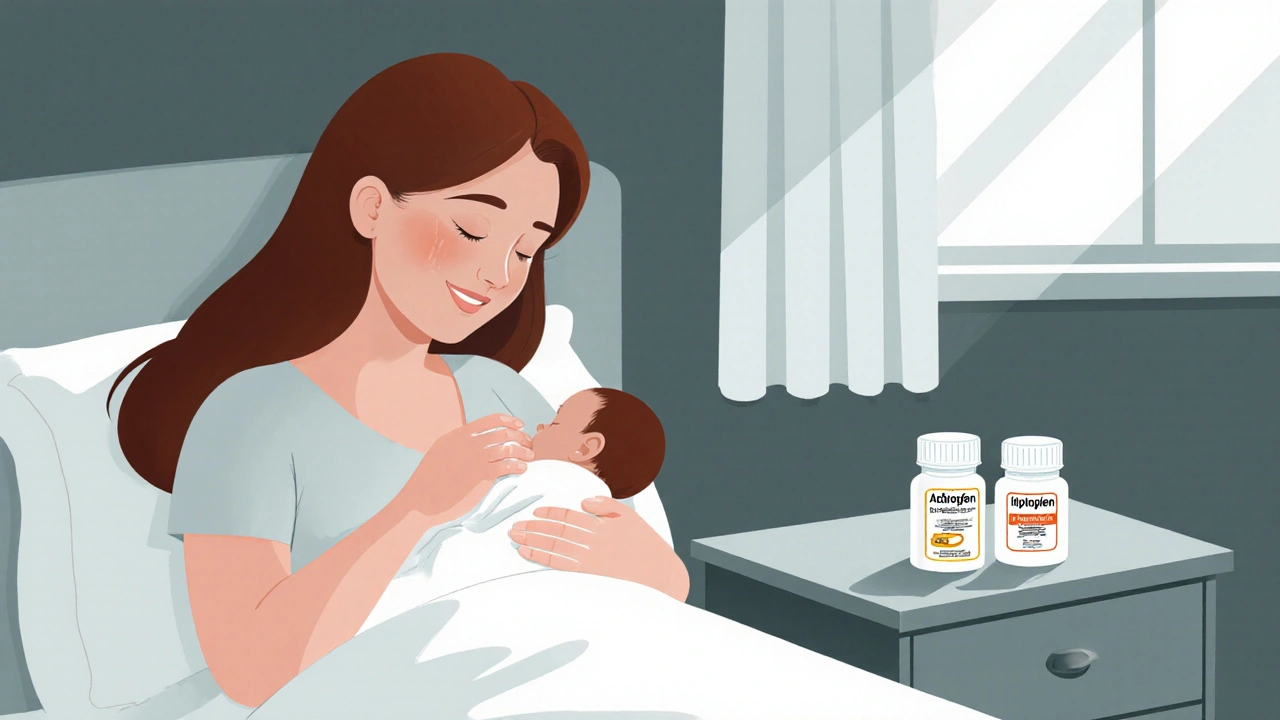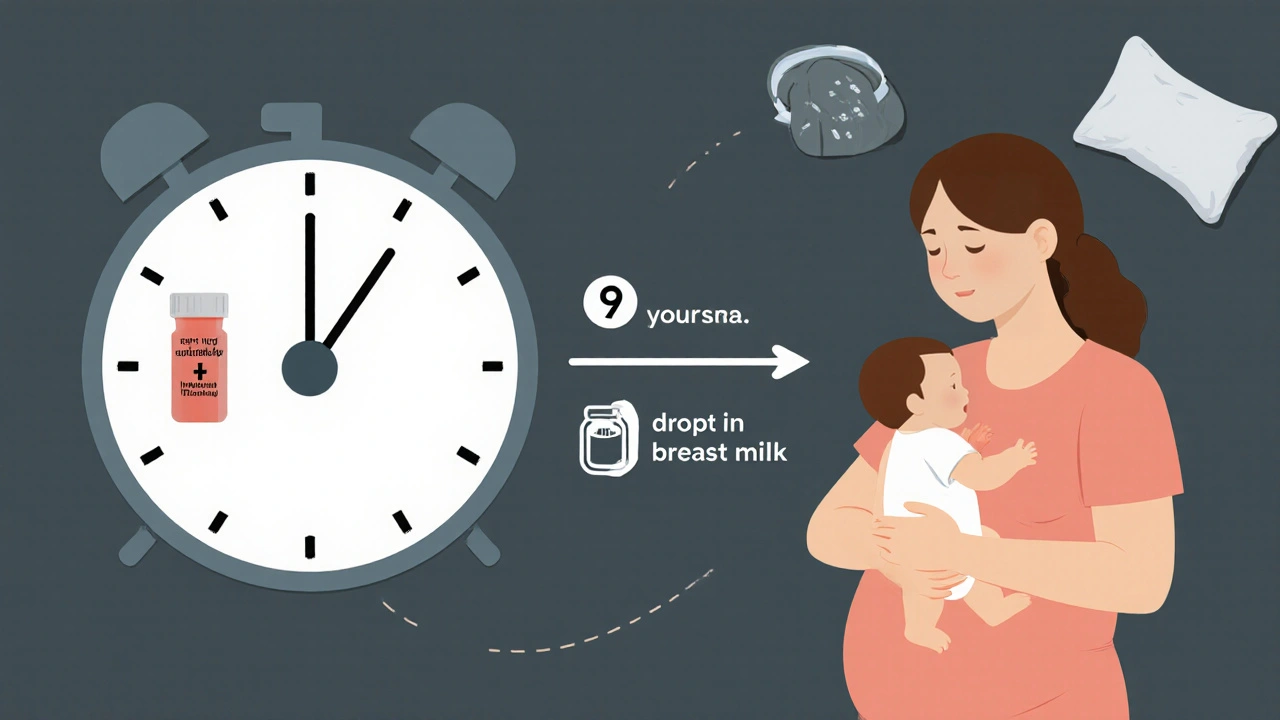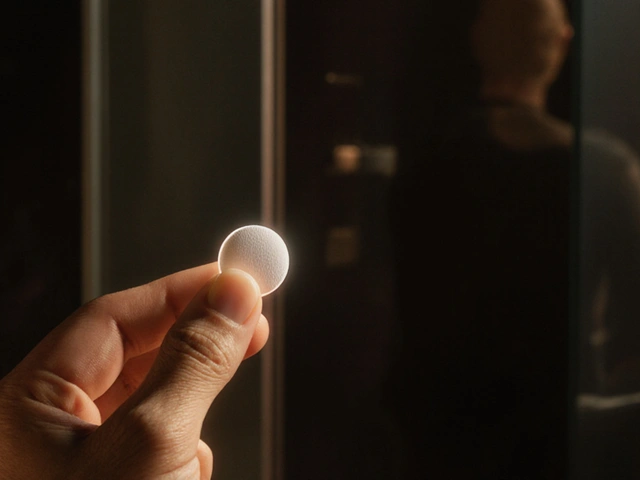
After giving birth, pain is normal. Whether you had a vaginal delivery or a C-section, your body has been through a major event. But if you're breastfeeding, choosing the right pain medication isn't just about feeling better-it's about keeping your baby safe. Many new parents worry: Can I take painkillers while nursing? The answer isn’t simple, but it’s clear: some medications are safe, some are risky, and a few should be avoided entirely.
Start with the Safest Options: Acetaminophen and Ibuprofen
The first line of defense for postpartum pain should be acetaminophen (Tylenol) and ibuprofen (Advil, Motrin). Both are considered safe for breastfeeding mothers, with minimal amounts passing into breast milk. According to the American College of Obstetricians and Gynecologists (ACOG), these are the preferred choices for pain relief during breastfeeding. The Michigan OPEN initiative confirms this, recommending them as first-line treatments even after C-sections.
Acetaminophen transfers into breast milk at just 0.1-1.0% of the maternal dose. Peak levels in milk happen about 1-2 hours after you take it. Ibuprofen is even lower-only 0.6-0.7% of your dose ends up in milk. That’s less than a teaspoon of medicine in a full bottle of breast milk. Neither affects your baby’s digestion, sleep, or development when used at standard doses.
For best results, alternate them every 3 hours. For example: take acetaminophen at 8 a.m., ibuprofen at 11 a.m., acetaminophen at 2 p.m., and so on. This keeps pain under control without doubling up on one drug. You can take them right before or after feeding-timing doesn’t matter much with these two. No need to pump and dump.
Why Codeine and Tramadol Are Dangerous
Some doctors still prescribe codeine or tramadol after delivery because they’re strong pain relievers. But they’re not safe for breastfeeding mothers-and here’s why.
Codeine is converted by your liver into morphine. But not everyone converts it the same way. About 1 in 100 women are ultra-rapid metabolizers. Their bodies turn codeine into morphine too fast, flooding breast milk with dangerous levels. The FDA issued a warning in 2017 after several infants died from morphine overdose through breast milk. Symptoms? Excessive sleepiness, trouble latching, shallow breathing. These signs can be easy to miss-especially when you’re exhausted.
Tramadol works the same way. It turns into M1, a potent opioid, in the liver. In ultra-rapid metabolizers, M1 levels in breast milk can spike dangerously. The FDA updated its warning in 2018 after more infant cases of respiratory depression. Even if you’re not an ultra-rapid metabolizer, there’s no way to know for sure without genetic testing-which isn’t routine.
Both drugs are now labeled with strong warnings: breastfeeding is not recommended. The American Society of Health-System Pharmacists says codeine should be avoided entirely, no matter the pain level. The Academy of Breastfeeding Medicine agrees. If you’ve already taken one dose accidentally, monitor your baby closely for 24 hours. But don’t take them again.
What About Other Opioids?
If you need something stronger than ibuprofen, you might be prescribed an opioid. Not all are equal.
Morphine is the safest opioid option for breastfeeding. Why? Babies absorb less than 1% of the morphine that gets into breast milk. It doesn’t cross into their bloodstream easily. The InfantRisk Center rates morphine as “moderately safe,” and it’s the go-to choice in hospitals for post-C-section pain.
Oxycodone is another option. It transfers into milk at 0.1-0.5% of the maternal dose. It’s acceptable for short-term use (4-6 days max), but it can cause drowsiness or constipation in babies. Watch for signs: if your baby is unusually sleepy, doesn’t wake to feed, or seems floppy, contact your doctor.
Hydrocodone, fentanyl, and hydromorphone are also considered moderately safe-but only when used carefully. Avoid long-term use. Never combine with other sedatives. And always time your doses wisely.

Timing Matters: When to Take Medication
If you’re using an opioid, timing your doses can make a big difference. Take the medication right after you breastfeed, not before. That way, your baby gets the least amount of medicine during the next feeding.
Peak levels in breast milk happen 1-2 hours after you take the pill. So if you take oxycodone at 7 p.m., wait until 9 or 10 p.m. to nurse again. That gives your body time to clear some of the drug. For babies under 2 months, this is even more important-their livers can’t process opioids as well.
For acetaminophen and ibuprofen, timing doesn’t matter. You can take them anytime. No need to wait. No need to pump.
What to Avoid: Naproxen, Indomethacin, and Others
Some NSAIDs are riskier than others. Naproxen (Aleve) and indomethacin aren’t recommended for new mothers. They stick around in breast milk longer. At 24 hours after a dose, naproxen levels can reach 1.5-2.0% of the maternal dose-higher than ibuprofen or acetaminophen.
These are especially risky for premature babies or newborns under a month old. Their kidneys and livers aren’t mature enough to clear these drugs. The Breastfeeding Network advises avoiding them unless absolutely necessary-and even then, only for a few days.
Aspirin is also not recommended. It can cause Reye’s syndrome in infants, a rare but serious condition. Stick with acetaminophen or ibuprofen.
How to Monitor Your Baby
If you’re taking any opioid-even morphine or oxycodone-watch your baby closely for the first 24 hours after each dose. Look for:
- Excessive sleepiness (hard to wake for feeds)
- Poor latching or weak suck
- Shallow or irregular breathing
- Constipation or reduced stools
- Unusual floppiness or limpness
If you notice any of these, stop the medication and call your doctor or pediatrician. Don’t wait. Early signs of opioid overdose in infants can be subtle, but they escalate fast.
For acetaminophen and ibuprofen, no monitoring is needed. These are safe at standard doses. You can nurse normally.

What About Anesthesia After Delivery?
You might have heard the old advice: “Pump and dump for 24 hours after anesthesia.” That’s outdated. The Academy of Breastfeeding Medicine updated its guidelines in 2021, removing all recommendations for this practice. Modern anesthetics leave your system quickly. The amount in breast milk is tiny. You can breastfeed right after waking up.
Even if you had general anesthesia, you don’t need to wait. Skin-to-skin contact and early feeding help both recovery and bonding. There’s no need to discard milk.
What’s Next? Genetic Testing and Future Options
Right now, there’s no routine test to find out if you’re an ultra-rapid metabolizer of codeine or tramadol. But researchers at Mayo Clinic published a 2023 study showing it’s possible. Testing for CYP2D6 gene variants could identify high-risk mothers before prescribing these drugs.
It’s not standard care yet. But in the future, it might be. Until then, the safest choice is simple: avoid codeine and tramadol completely. Use acetaminophen and ibuprofen first. If you need more, choose morphine or oxycodone-and use them briefly, carefully, and with close monitoring.
Bottom Line: Safe, Simple, and Effective
Managing pain after birth doesn’t mean giving up breastfeeding. In fact, the benefits of breastfeeding far outweigh the tiny risks of most medications. Acetaminophen and ibuprofen are your best friends. Avoid codeine and tramadol at all costs. Use stronger opioids only when necessary, for short periods, and with careful timing. Monitor your baby. Trust your instincts. And know that you’re not alone-millions of mothers have done this safely.
Your pain matters. Your baby’s safety matters. You can have both.
Shivam Goel
Acetaminophen and ibuprofen? Yes. But let’s be real-most OB-GYNs still push oxycodone like it’s candy. I had a C-section, and my doctor prescribed oxycodone + acetaminophen combo-no warning about infant drowsiness. I only found out by Googling at 3 a.m. while rocking a barely-breathing baby. Don’t trust the script. Trust the literature.
Archana Jha
wait… so if you’re a ultra-rapid metabolizer… and your baby gets morphine through breastmilk… isn’t that basically… like giving your baby a tiny dose of heroin? 😳 i mean… why isn’t this on the news? why aren’t hospitals required to test every new mom’s DNA before handing out pain meds? i’m not being dramatic-my cousin’s friend’s sister’s baby went into respiratory arrest because of codeine. they didn’t even know it was in the medicine. the system is broken. we’re all lab rats.
Aki Jones
Let’s not ignore the pharmacokinetic implications here. The CYP2D6 polymorphism isn’t just a ‘risk’-it’s a pharmacogenomic time bomb. And the fact that the FDA’s warning is still considered ‘optional’ in clinical practice is a catastrophic failure of translational medicine. We have the data, we have the tools, but we’re still operating on 1990s protocols. This isn’t negligence-it’s institutionalized recklessness.
Andrew McAfee
Man I had my kid in India and they just gave me ibuprofen and said good luck. No one mentioned anything about timing or metabolizers. But honestly? My wife breastfed for 18 months and she’s fine. Baby’s smart as hell. Maybe we overthink this stuff too much. Sometimes just do what feels right
Elise Lakey
Thank you for this. I was so scared to take anything after my C-section, even ibuprofen. I thought I’d be poisoning my baby. This clarified so much. I’ve been alternating Tylenol and Advil every 3 hours like you said-and my baby’s been sleeping like a angel and nursing like a champ. You just made my first week bearable.
Kimberley Chronicle
As a neonatal nurse, I’ve seen too many mothers avoid pain meds entirely because they’re terrified-only to end up with severe postpartum depression or inability to bond. The data is clear: acetaminophen and ibuprofen are safe. The real danger is untreated pain. This post is a gift. Please share it with every new mom you know.
Agastya Shukla
Interesting that you mention CYP2D6 testing. In the UK, some tertiary centers are piloting pharmacogenomic screening for postpartum patients. It’s not widespread, but the cost-benefit analysis is compelling. Imagine avoiding one infant ICU admission per 5000 births-that’s one life saved for under $200 in testing. Why aren’t we scaling this?
Pallab Dasgupta
Y’all are overcomplicating this. I had twins. C-section. Took oxycodone for 4 days. Breastfed like a machine. My babies are now 3 and thriving. You want to be a perfect mom? Stop stressing over 0.5% of a pill. Eat. Sleep. Cry. Nurse. Repeat. You’re not a lab rat-you’re a warrior. And your baby knows it. Now go hug your kid and stop reading Reddit for 5 minutes.






Write a comment